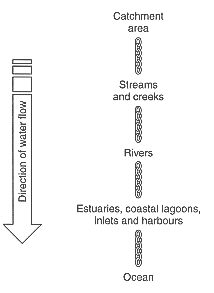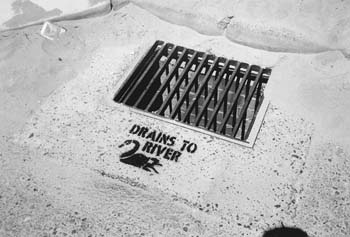
What are waterways and catchments?

|
| Figure 1-1: The waterways chain |
| A waterway is any inland stream, creek, river, coastal lagoon, inlet and harbour through which water flows to eventually meet the ocean |
A waterway's environment is made up of physical, biological and cultural components. The physical environment is the landforms through which the water flows, and the water itself. The biological environment consists of the creatures and plants which inhabit the physical environment. The cultural environment includes the waterway's scenic, recreational and historic uses. Waterways are dynamic and complex systems.
A waterway system is like a chain. A number of waterways drain water from the land to the sea. A basic waterway chain includes the catchment, streams and creeks, rivers, estuaries and the ocean. The diagram to the right shows the path of water from when it falls as rain to when it enters the sea.
Waterways come in all shapes and sizes. The salinity, temperature, depth and flushing rate are some of the elements which make waterways different from each other. The birds, animals and plants which inhabit the water and the foreshore all contribute to a waterway's uniqueness.

| A catchment is the surface area onto which rain falls then runs off and collects into a reservoir. Reservoirs include rivers, wetlands and underground basins. |
Water from a catchment may enter a waterway via surface flow (water running across the land) or by soaking into the ground and entering as groundwater.
Water from anywhere in a catchment ends up in its waterways. Anything which happens in a catchment can therefore ultimately affect the condition of its waterways. We need to manage what happens in a catchment in order to manage its waterways.
Definitions of waterway words are provided in a glossary.